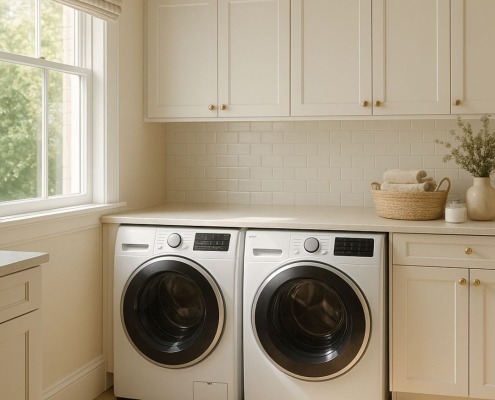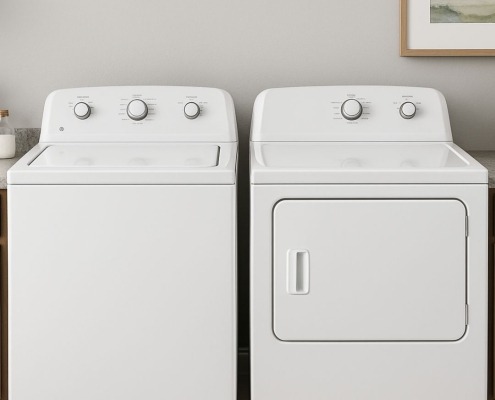How to replace a Whirlpool washing machine water inlet valve
Steven E / Friday April 25, 2025
Is your Whirlpool washing machine struggling to fill or making odd noises? You might be facing a common issue with the water inlet valve. Don’t worry—our step-by-step guide and instructional video below will help you replace the valve yourself, saving you the hassle and expense of a repairman.
Looking for the right part? Enter your appliance model number below to find the exact match and get your appliance running like new again!
Doing repairs on household appliances can seem daunting, but replacing the water inlet valve on a Whirlpool washing machine is a straightforward job that can be done by most DIYers in no time. We’ll cover all the basics you need to know. With the right materials and safety precautions, you can upgrade your machine with a brand-new water inlet valve and get your Whirlpool washer running like new again.
You can find a replacement water inlet valve here. If you need other replacement parts for your Whirlpool washer, just enter your model number at AppliancePartsPros.com to find them. It’s that easy! Most orders arrive in just two business days, and we have thousands of guides to show you how to install your new parts.
The information in this article may not apply to your specific appliance model. We recommend consulting your manufacturer’s documentation or contact us with any questions.
Watch: How to replace water inlet valve
What the valve does
The water inlet valve controls the flow of both hot and cold water into the washing machine during the fill cycles. It contains solenoids that act like electric switches to turn the water on and off based on the wash settings and signal from the control board or timer. Over time, these solenoids and valves can wear out or get clogged with mineral deposits, causing issues like failed fill cycles, leaking, overflowing, and strange noises when the machine is filling. The good news is that Whirlpool washing machines make the replacement process very straightforward for DIYers. With the right Whirlpool water inlet valve part number and basic tools, it can be completed in no time even if you aren’t highly experienced with appliance repairs.
When to replace the valve
There are a few obvious signs that indicate it’s time to replace your Whirlpool water inlet valve:
- No water entering the washer – This could point to failed solenoids that are preventing water from being turned on. No water at all means the valve needs to be replaced.
- Overflowing or leaking issues – A malfunctioning valve that doesn’t turn off appropriately can lead to overfilling, water overflowing the tub, or leaking during the fill cycles.
- Strange noises when filling – Loud humming, buzzing, clicking, or other abnormal sounds from the valve area during the fill process usually means the solenoids are wearing out.
- Low water pressure – Inlet valves accumulate mineral build-up over time which restricts water flow. If your washer isn’t filling properly, low pressure could indicate a clogged-up valve.
- Age of the washing machine – Inlet valves gradually wear out over 5-10 years of use. Even without other symptoms, replacing an aging valve can prevent future problems.
Tools and materials
- Replacement part (make sure it’s compatible with your model before installing)
- Pliers
- 1/4″ nutdriver
- Putty knife
- Torx 20 driver
Safety precautions
When working on any appliance, remember to keep safety first. Here are some tips to keep in mind:
- Always power off and unplug your appliance or switch off the circuit breaker before attempting any maintenance or replacement work. This keeps you safe by preventing any risk of injury from electric shock.
- Wear insulated work gloves to protect your hands from sharp metal parts, pinching hazards and debris.
- Take your time and don’t rush while working to prevent accidents and personal injuries.
- Work in a well-lit area so you can clearly see and access the interior parts.
- Clear your workspace of clutter and other obstacles. Keep children and pets away from the work area.
- Never work on internal parts with bare wet hands. Make sure the work area is completely dry.
- Check your user manual to see if there are specific installation or safety instructions for your part or appliance.
- Be gentle when handling or removing parts. Excessive force might damage the appliance or cause injury.
- Wear safety glasses when working with chemicals, dust or cleaning large debris to prevent injury.
- If the appliance has recently been used, give it plenty of time for any heating parts to cool down before working on it.
- Take pictures or make a note of wiring terminals or other connections before disconnecting to prevent any problems with reassembly.
- When working with wires, avoid touching any exposed wires or terminals. If you need to touch a wire, use a non-conductive tool or wear insulating gloves to prevent electrical shock.
- Don’t test wiring with a multimeter for live voltage if you’re unfamiliar with how to prevent short circuiting when testing.
- Turn off the water supply at the outlet before beginning repairs to any appliance parts that hold water. Have towels ready for any residual water in the system when removing parts.
Replacement steps
- Unplug the washer or turn off the circuit breaker to avoid electric shock. Also turn off the hot and cold water supply lines.
- Remove the fill hoses from the back of the washer by using pliers to break them free, then unscrew them by hand. Be sure to label the hoses so they are not mixed up later.
- Remove the smaller access panel on the bottom front of the washer by taking out one screw with a nut driver. Swing the panel over and remove the two retaining tabs.
- Remove the larger access panel on the bottom front by taking out two screws with a nut driver. Pull the panel out and off of the washer.
- Use a putty knife to release the locking tabs on each side of the console and lift it up. Carefully flip the console over.
- Unplug the wiring harness from the control board by pressing the locking tab and pulling it out. Route the harness out of the way.
- Remove the two screws holding the water inlet valve in place using a torque screwdriver. Pull the old valve out.
- Insert the new valve into the hole, pushing it into place. Secure it with the two screws.
- Route the wiring harness back under the control board wires and plug it back into the control board, ensuring it locks into place.
- Rotate the console back down and snap the front locking tabs into place.
- Reinstall the access panel with the two screws.
- Replace the smaller panel with one screw.
- Screw the fill hoses back onto the new valve and tighten them with pliers.
- Reconnect water and power, then test the washer by running a cycle.
More information
Thanks for reading! We hope this article helped you replace the water inlet valve in your Whirlpool washer. If you still need some replacement parts, grab your model number and head over to AppliancePartsPros.com. We offer over 2 million parts and most orders arrive in 2-3 business days. If you need some help with finding the right part or placing an order, you can contact our team at 1 (877) 477-7278.
While you’re waiting for your new part to arrive, you can explore our DIY blog and watch thousands of video tutorials on our YouTube channel.
Be sure to follow us on Facebook, Twitter and Instagram to see our latest repair guides!
With nearly a decade of experience in providing top-notch customer service regarding appliance parts and repair, Steven enjoys sharing practical advice, troubleshooting tips, and interesting information to help readers stay informed.





